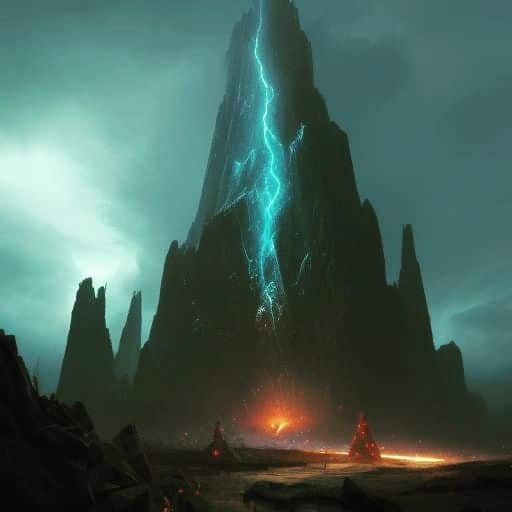Helheim or Hel (Old Norse Helheimr) is the lowest of the Nine Realms in Norse cosmology. This underground place is the realm of the dead. Ruled by the cold and uncaring Hel – queen of the dead.
As a resting place for the majority of the dead, this is not a place of punishment but simply a residence of the deceased. Those who died of illness or old age or were considered cowards or dishonorable by the gods and goddesses – were sent into the underworld, where they could never leave.
The souls of those who drowned belong to goddess Rán – wife of the sea god Aegir, while the ones fallen during the battle go to Odin’s Valhalla or Freyja’s Fólkvangr.
Etymology
The name of the underworld is directly taken from the Old Norse word “Hel” – meaning “hidden.” That may be a reference to Hel’s distant, underground location.
The word has linguistic equivalents in all branches of the Germanic languages, including Old English hell (and thus Modern English hell), Old Frisian helle, Old Saxon hellia, Old High German hella, and Gothic halja. All these forms derive from the reconstructed Proto-Germanic feminine noun xaljō – meaning “concealed place.”
Where Is Helheim and What Does It Look Like?

Helheim, as a subterraneous place, is positioned in the cold, dark north and is buried deep underneath one of three roots of the world tree Yggdrasil. Although Helheim is not a place of punishment of any kind – it is far from a pleasant realm overall. This world is damp, dark, cold, dreary, and misty.
Difference between Hel and Hell
If someone is naive enough to think that the Norse realm of the dead and the Christian concept of hell share a lot of similarities – they would certainly make a big mistake. Apart from the fact Hel and Hell are both the realms of the dead and located underground, these concepts have little in common.
Old Norse sources aren’t very clear about how someone ended up in one of the afterlife realms. However, what is clear is that if someone died, according to Norse belief, his departure to the underworld was not a reward for his moral behavior, nor had it been a punishment for his sins.
The dead in Hel did the same things that the men and women of the Viking Age did while they were among the living: eating, drinking, sleeping, fighting, and so on. It was simply the continuation of life, only in a different place.
Description of Helheim in Old Norse Texts
The realm of Helheim and its queen Hel is discussed in one of Snorri Sturluson’s stories – Gylfaginning, a section in his Prose Edda. Here we can find out more about this bleak and cold place.
Sturluson describes a dark and dreary hall in Helheim called Éljúðnir (misery), where the queen of the dead eats from a dish called “hunger” with a knife called “famine.” With these descriptions, he indicates that no amount of food can fill the empty stomachs of the dead. He calls her bed “disease,” suggesting that there is no amount of sleep sufficient to relieve the weariness of the dead.
Hel he cast into Niflheim, and gave to her power over nine worlds, to apportion all abodes among those that were sent to her: that is, men dead of sickness or old age. She has great possessions there; her walls are exceeding high and her gates great.
Her hall is called Sleet-Cold; her dish, Hunger; Famine is her knife; Idler, her thrall; Sloven, her maidservant; Pit of Stumbling, her threshold, by which one enters; Disease, her bed; Gleaming Bale, her bed-hangings. She is half blue-black and half flesh-color (by which she is easily recognized), and very lowering and fierce.
The Road to Hel
How often gods and mortals visited the underworld can be seen by the very expression that become established among the Norse – Helvegr. Its meaning – “The Road to Hel” – directly refers to the path or route that leads straight to the underworld.
Old Norse sources describe in an uncharacteristically detailed manner the path one had to take to reach the realm of the dead. After a long journey through darkness and mist, the traveler would reach river Gjöll – the river of clanging swords and spears. Then one would have to cross the bridge Gjallarbrú over that river to get closer to Hel.
After a while, the traveler would finally arrive at the wall or fence surrounding Hel (which is variously called Helgrindr – Fence of Hel, Nagrindr – corpse fence, and Valgrindr – fence of the fallen).
Helheim is guarded by the fearsome hound Garmr. This beast is Hel’s black hound – chained up in Gnipahellir, a cave at the entrance to the land of the dead. This concept is similar to how – in Greek mythology – Cerberus – the three-headed guard dog – guards the entrance to Hades’ underworld.
Location of Hel – Nord og Ned
The Norsemen believed that walking the Helvegr could only be accomblished after having passed on to the afterlife. Like the ancient Greeks underworld Hades was below ground, Hel was also thought to be somewhere under Midgard. However, there are also mentions of Hel being located in the far north, placing it closer to, or inside the primordial realm of Niflheim.
The road to Hel is said to be “north, and down” which interestingly still is a saying in Norway today. If I was to tell someone in Norwegian to go “Nord og ned”, I’m wishing them or their endevour to go to hell. And not in a nice way.
The Living could also visit Hel
An example of such a journey to the realm of the dead can be seen in the poem Baldr’s Draumar from Poetic Edda (stanzas 2 and 3). This story begins with Frigg, Odin’s wife and mother of the loveliest and most beloved of all the gods – Baldur – dreaming of her son’s death. Worried, Odin rode to Hel in search of the völva, a prophetess who would explain Frigg’s disturbing vision. In her prophecy, we learn a lot about the underworld realm:
Then Othin rose, | the enchanter old,
And the saddle he laid | on Sleipnir’s back;
Thence rode he down | to Niflhel deep,
And the hound he met | that came from hell.
Bloody he was | on his breast before,
At the father of magic | he howled from afar;
Forward rode Othin, | the earth resounded
Till the house so high | of Hel he reached.
Is Helheim a Part of Niflheim?
Some sources claim that Helheim’s location is within the realm of Niflheim. But, that claim appears to be a later addition after the influence of Christianity. Along with Muspelheim, Niflheim is the oldest of the nine realms. Primordial land of ice, mist, and snow, where all life began upon the world’s creation.
Sturluson equated Niflheim with Niflhel (meaning “dark realm of Hel”), leading to his understanding that Hel’s realm was within Niflheim. If Niflhel existed in Norse cosmology before Christian influence, as it appears to have, there is no mention of it later within Niflheim. Maybe it was located even below it.
However, considering Niflheim’s nature, it has nothing to do with the dead. It is a cold, misty, and ice-bound realm inhabited by no one, not even Frost Giants. Since it states in later sources that Odin threw Hel into Niflheim, where he gave her power over the dead, the thought is that she did pass through Niflheim to Niflhel and remained there to rule.
Her Majesty the Queen of the Dead
Hel (Old Norse Hidden) is the queen of Helheim, the afterlife realm of the dead, which was often called the same as she did – Hel. Although often referenced as a goddess, Hel is more of a half-goddess and jötunn – an entity from Jotunheim, a realm of the giants.

Even though the personality of the queen of the dead hasn’t been described much in Old Norse literature, the thought is that she was a cruel ruler, greedy and harsh. Icelandic scholar Snorri Sturluson describes her appearance as half a beautiful woman and half decomposing corpse.
Her name refers to the underworld in Norse cosmology. The hidden place underneath the earth’s ground where their souls are invisible to the living.
Hel is the daughter of the trickster god Loki and the giantess Angrboda. As well as sister to the world serpent Jormungand and the great wolf Fenrir.
Existence of Hel in Pre-Christian Scandinavia
Some scholars suggest that Hel did not exist in Nordic beliefs before Christian influence. However, that cannot be said for sure because there is no written record. Her emergence matches with the 13th-century sources, mostly preserved by Sturluson.
He is known to have altered some pagan motives in the stories to make them more acceptable to Christians. Thus, the thought is that she was an example of those changes. Prior to this it seems that Hel was formerly the name of a grave or burial ground. As such there was no mention of any supernatural being overseeing it.
Hel and Ragnarök
When the fateful twilight of the gods and devastation of everything that existed finally comes, Hel is playing an important role. Her and Helheim’s involvement in Ragnarök is shared by the völva in Völuspá. From the Poetic Edda, Völuspá stanzas 38, 39, and 51.
A völva tells Odin that Hel would open its gates and unleash the dead upon the world of the living. Her army of the dead will embark on the ship Naglfar. Famously built of of the fingernails and toenails of the dead. Hel and her army will then set sails for the vast field of Vigrid. There the final battle of Ragnarök will take place.
- A hall I saw, | far from the sun,
On Nastrond it stands, | and the doors face north,
Venom drops | through the smoke-vent down,
For around the walls | do serpents wind.
- I saw there wading | through rivers wild
Treacherous men | and murderers too,
And workers of ill | with the wives of men;
There Nithhogg sucked | the blood of the slain,
And the wolf tore men; | would you know yet more?
- O’er the sea from the north | there sails a ship
With the people of Hel, | at the helm stands Loki;
After the wolf | do wild men follow,
And with them, the brother | of Byleist goes.
FAQs about Helheim
Helheim and Niflheim are two different realms. Some sources claim that Helheim – a realm of the dead, is located within Niflheim – primordial land of ice and mist. That claim appears to be a later addition after the influence of Christianity. It seems that Helheim is even beneath Niflheim.
Hel is the queen of Helheim, the afterlife realm of the dead. Hel is more of a half-goddess and jötunn – an entity from Jotunheim, a realm of giants. She is the daughter of the trickster god Loki and the giantess Angrboda.
Hel or Helheim is a subterraneous place located in the cold, dark north. Although Helheim is not the place of punishment for the dead, it is far from a pleasant realm overall. This world is damp, dark, cold, dreary, and misty.
Featured Image Credit: krets_ai_art
